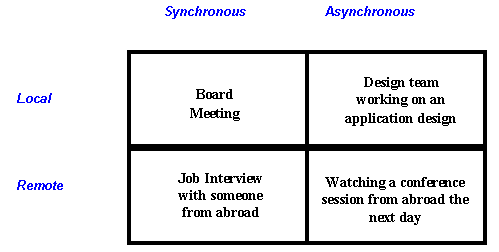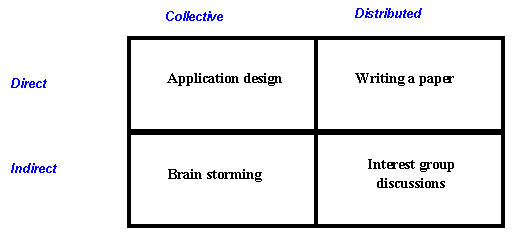
June 2010 Edition
Computer Science Department, University of Cape Town
| MIT Notes Home | Edition Home |
 | MSc-IT Study Material June 2010 Edition Computer Science Department, University of Cape Town | MIT Notes Home | Edition Home | |
As international economies have risen in their importance so has the importance of international collaboration. The costs of international travel in time, money and physical exhaustion compares unfavourably with the alternative of installing and using CSCW tools and applications
Previous concentration by disciplines such as HCI on one user one application support has hindered the development of multiple user applications and tools.
Defining the group work which requires support Detailing which aspects of group working the CSCW system & software support Identifying what potential obstacles the technology may impose on group working.
The rigid specific sub-task assigned project of writing a co-authored book requires group members to be able to work in a staggered manner working, for portions of their time, alone and non-collaboratively. An asynchronous application would therefore support these work practices. A brain-storming task, however, requires group members to respond immediately to collaborative participants and requires a synchronous application to support this form of cooperation.
FALSE: This would be classified as a collective indirect (not direct) collaboration as the collaboration is mediated by the task changes and not the group members in direct interpersonal communication.
The task may change without some members being aware of it and thus these group members may be working on something already discarded as unimportant by the rest of the group.
A lack of system feedback to the user that the system was still on, what other users could see made the office worker feel secure in his physical surroundings that the situation was private when it was not.
In identifying the tools and applications it may help to fill in a table (below is what Dix, et al. 1998 describe as a time and space matrix). Below are some examples of the tasks to be supported by the tools and applications.

In identifying the tools and applications it may help to fill in a table (below is what Dix, et al. 1998 describe as a time and space matrix). Below are some examples of the tasks to be supported by the tools and applications.

To help identify these cues consider:
With verbal cues it will help to think of intonation, tones, flow of the conversation
With non-verbal cues it will help to think of body language, eye contact, actions
To help identify these cues consider differences between cultures for:
With verbal cues it will help to think of intonation, tones, flow of the conversation
With non-verbal cues it will help to think of body language, eye contact, actions
It is important to understand that technology is not appropriate for all situations and in some contexts may impede effective real-world interactions. It has recently been argued that people teleworking need to have occasional face-to-face meetings to ‘stay in touch’ with what is going on. Many of the reasons behind this need for real-world meetings relates to social interaction issues of trust, relationships etc.
Within different cultures variations in social norms (e.g. privacy requirements, communication norms) can cause problems with communications. Interpersonal distance has been found to dictate the intensity of a response: faces in a close-up are scrutinised and attended to more often than those in the background. Yet, between cultures the personal space required for comfortable interactions varies. How would you allow for the right distance, in an application, to increase attention levels yet allow for variations in personal space?